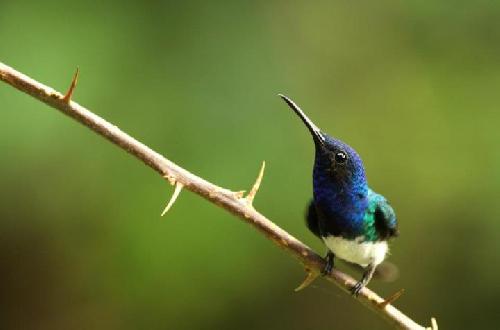A new study has mapped food specialization in hummingbird communities across the Americas, leading to a rare documentation of a large scale ecological pattern. It reveals that communities with high levels of food specializations coincide with a high number of smaller-ranged species. The study provides an evolutionary insight into how and where ecological specialization might occur. The study was led by the Center for Macroecology, Evolution and Climate at the University of Copenhagen.
A complex network analysis of hummingbirds and the nectar plants they feed on was used to determine the level of resource specialization in 46 hummingbird communities distributed widely from the Northern USA to Southern Brazil.
The study is published today in the journal Proceedings of the Royal Society B by a team of more than 30 scientists.
 This is a white-necked Jacobin (Florisuga mellivora). Hummingbirds have the highest metabolic rate among all vertebrates, with a heart rate above 1,200 beats per minute, allowing them to hover in front of the flowers while beating their wings up to 200 times every second. Credit: Jesper Sonne
This is a white-necked Jacobin (Florisuga mellivora). Hummingbirds have the highest metabolic rate among all vertebrates, with a heart rate above 1,200 beats per minute, allowing them to hover in front of the flowers while beating their wings up to 200 times every second. Credit: Jesper Sonne
"Using hummingbirds as an example, we have demonstrated a distinct pattern for ecological specialization across a large geographical space. No matter where we look across the Americas it holds true that high food specialization in a community is linked to a high proportion of smaller-ranged species. The explanation for this is thought to be that a stable climate over a long period of time is able to foster both. Patterns like these help us explain and understand biodiversity on a large scale" says lead author and MSc student Jesper Sonne from the Center for Macroecology, Evolution and Climate at the University of Copenhagen.
Director of the center Professor Carsten Rahbek adds:
"With this study, we demonstrate that environmental factors such as the climate not only associate with species ranges, but also with local specializations, such as those between hummingbirds and nectar plants. It gives us an insight into how evolutionary and ecological processes jointly structure biological communities in a broad sense."
For the hummingbird communities that were investigated, the smallest species ranges were around 40,000 km2 which compares to an area smaller than the size of Denmark, while the largest ranges were about 1,000 times greater. Hummingbirds with even smaller ranges exist but were not included in the study because no information is available on their interactions with plant communities.
The study included 130 hummingbird species, representing ca. 40 % of all hummingbird species. The Volcano Hummingbird (Selasphorus flammula), White-bellied Mountain-gem (Lampornis hemileucus) and Fiery-throated Hummingbird (Panterpe insignis) are all examples of species that were classified as smaller-ranged in the study. All three live only in Costa Rica and western Panama and they were found to be locally specialized to feed on particular nectar plants.
The results also indicate that aggregations of smaller-ranged species are more vulnerable to environmental change than previously thought.
"Species with smaller geographical ranges are naturally more sensitive to environmental change, and if the same community of species is also highly specialized to forage on few food resources, it will be less capable of adapting to a changing environment" says co-author and Assistant Professor Bo Dalsgaard from the Center for Macroecology, Evolution and Climate.
Hummingbirds and their nectar plants have long served as model system for examining ecological and evolutionary processes because of their strong mutual dependencies. They are also known to thrive in an array of environments throughout the Americas from Alaska to Tierra del Fuego. Hummingbirds can weigh as little as 2 grams and have extremely diverse bills, adapted to fit their nectar plants.
source: Faculty of Science - University of Copenhagen